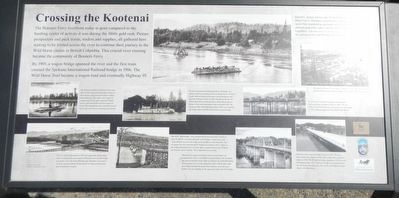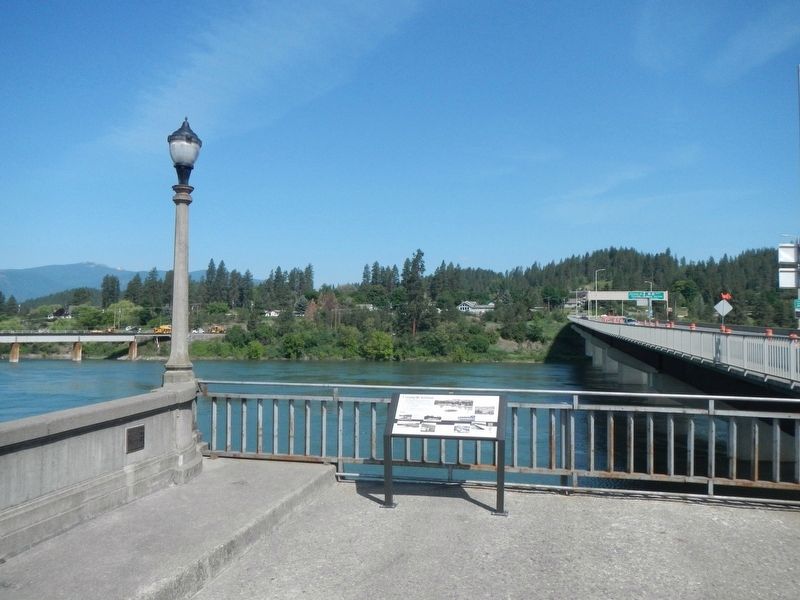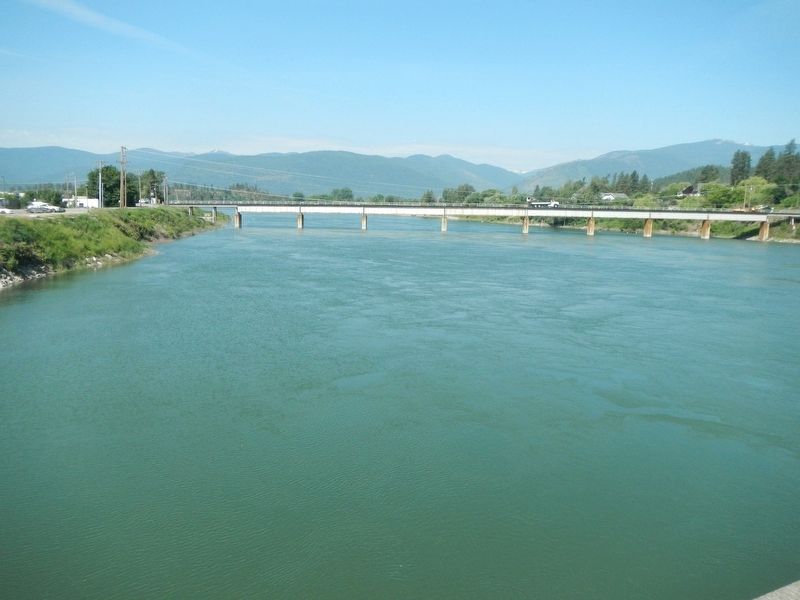Bonners Ferry in Boundary County, Idaho — The American West (Mountains)
Crossing the Kootenai

Photographed By Barry Swackhamer, May 8, 2018
1. Crossing the Kootenai Marker
Captions: (top center) Edward L. Bonner and two other Walla Walla merchants traveling the Wild Horse Trail in 1864 knew a good business opportunity when they saw it. The negotiated an agreement with the Kootenai Tribe and were granted the right to operate a ferry by the Idaho Legislature. Toll rates were $1.50 for a loaded .... for a person on foot, and 20 cents each for sheep.; (upper right) This photo of Bonners Ferry gives a birds-eye view showing both the Spokane International Railroad bridge (left) and the 1910 bridge (right).; (middle right) The Kootenai people traveled the rivers and lakes of this region for thousands of years in their unique sturgeon-nosed canoes crafted from white pine. The valley was a maze of cottonwood forests, lakes, mud and shallow waters, and canoes were the best means of travel. The meandering river was both a travel route and a rich area for hunting and fishing.; (center) The first steamboat on the Kootenai River, the Midge, was pushed, pulled, shoved and carried overland from the Northern Pacific station at Kootenai, east of Sand Point, and launched at Bonners Ferry in 1884. Steamboats, like the S.S. Alberta (left) also carried passengers and products between Bonners Ferry and communities to the north until 1905. The Kootenai Valley Railroad bridge, built in 1899, was a turnstile type bridge which allowed sternwheelers to pass through.; (middle right) The first train crossed the Spokane International Railroad bridge in Bonners Ferry in 1906. The old bridge collapsed during the construction of a new bridge in 1985, dumping eight cars into the Kootenai River.; (bottom left) The low water bridge built in 1905 was impassable during the high water in spring and early summer. When the center of the bridge was under water, the ferry filled the gap. Dynamite was used to break up logjams and the bridge had to be repaired every year after floodwaters receded. (bottom center-left) The 1910 "high bridge" was constructed of wood and steel. Unable to raise $1,100 for a wooden sidewalk on the bridge, citizens were told "You will have to cross the bridge in the middle or walk along the side." A woman was once knocked off the bridge by a careless driver. Signs on the bridge limited speed to no faster than a walk for horses and 10 miles per hour for motor vehicles. The weight limit was six tons.; (bottom center-right) When the five-span steel girder and concrete bridge was completed in 1933, it was Idaho's longest bridge. One hundred-fifty men worked five-hour shifts to complete the $200,000 Public Works project in a record-setting four and a half months! This new bridge included the pedestrian walkway its predecessor lacked. You are standing on the approach of the old 1933 bridge.; (bottom right) Plans for a new concrete bridge began in 1982. The four-lane construction began in 1983 and a single-lane opened to traffic in 1984. The $9 million bridger, spanning 1,378 feet, was dedicated in May, 1987. Each new bridge was constructed to the east of the preceding one. As a result, the bridge no longer aligns with Main Street.
Erected by Boundary County Historical Society.
Topics. This historical marker is listed in these topic lists: Bridges & Viaducts • Waterways & Vessels.
Location. 48° 41.904′ N, 116° 18.738′ W. Marker is in Bonners Ferry, Idaho, in Boundary County. Marker is on Main Street near U.S. 95, on the left when traveling west. Touch for map. Marker is at or near this postal address: 7229 Main Street, Bonners Ferry ID 83805, United States of America. Touch for directions.
Other nearby markers. At least 8 other markers are within walking distance of this marker. Pelton Wheel (within shouting distance of this marker); Solving Power Problems (within shouting distance of this marker); Electrifying Bonners Ferry (within shouting distance of this marker); Logging Railroads (about 300 feet away, measured in a direct line); Railroad Services (about 300 feet away); Railroad Laborers (about 300 feet away); Spokane International Railway (about 300 feet away); Kootenai Valley Railway (about 300 feet away). Touch for a list and map of all markers in Bonners Ferry.
More about this marker. The marker is located at the Riverfront Park on the old bridge approach.
Credits. This page was last revised on August 30, 2018. It was originally submitted on August 30, 2018, by Barry Swackhamer of Brentwood, California. This page has been viewed 289 times since then and 24 times this year. Photos: 1, 2, 3. submitted on August 30, 2018, by Barry Swackhamer of Brentwood, California.

